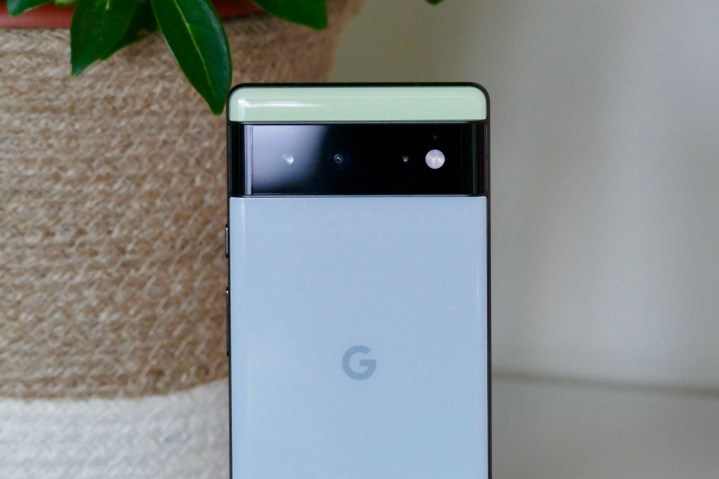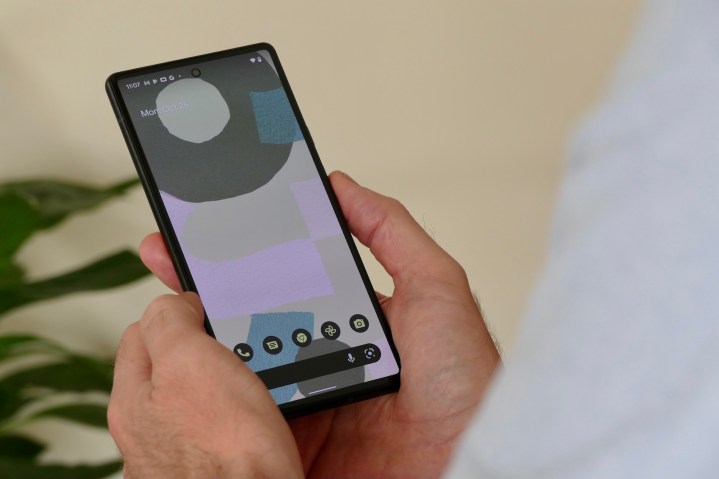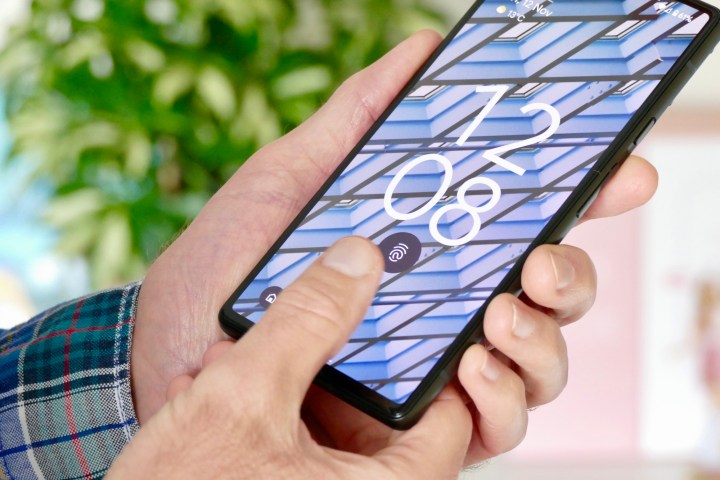In the market for the latest flagship? Comparing specs to choose the perfect phone can be a chore, and if you’re struggling to choose between the new OnePlus 10T and Google Pixel 6, we hear you. With its stunning 6.7-inch AMOLED 120Hz display, powerful Snapdragon 8 Plus Gen 1 chipset, and 4,800mAh battery with 125W SuperVOOC charging, the OnePlus 10T seems like a no-brainer. But what about the Google Pixel 6’s Tensor chip, wireless charging, and outstanding cameras?
We’ve compared the OnePlus 10T vs. Google Pixel 6 across six core categories to help you decide which to buy, so keep reading to figure out which is best for you.
Specs
| OnePlus 10T | Google Pixel 6 | |
| Size | 163 x 75.37 x 8.75mm (6.42 x 2.97 x 0.34 inches) | 158.6 x 74.8 x 8.9mm (6.24 x 2.94 x 0.35 inches) |
| Weight | 203.5 grams (7.18 ounces) | 207 grams (7.30 ounces) |
| Screen size | 6.7-inch Fluid AMOLED with 60 to 120Hz adaptive refresh rate | 6.4-inch OLED with 10 to 90Hz adaptive refresh rate |
| Screen resolution | 2412 x 1080 (394 ppi) | 2340 x 1080 pixels (411 ppi) |
| Operating system | Android 12
OxygenOS 12.1 |
Android 12 |
| Storage | 128GB, 256GB | 128GB, 256GB |
| MicroSD card slot | No | No |
| Tap-to-pay services | Google Pay | Google Pay |
| Processor | Snapdragon 8 Plus Gen 1 | Google Tensor |
| RAM | 8GB, 16GB | 8GB |
| Camera | 50MP main, 8MP ultrawide, 2MP macro, 16MP front | 50MP wide, 12MP ultrawide rear, 8MP front |
| Video |
4K at 30 fps/60 fps 1080p at 30 fps/60 fps |
4K at 30 fps/60 fps,
1080p at 30 fps/60 fps |
| Bluetooth version | Bluetooth 5.3 | Bluetooth 5.2 |
| Ports | USB-C | USB-C |
| Fingerprint sensor | Yes (in-display) | Yes (in-display) |
| Water resistance | IP54 | IP68 |
| Battery | 4,800mAh
150W SuperVOOC charging (capped at 125W in the U.S.) |
4,614mAh
30W wired charging 21W wireless charging Reverse wireless charging |
| App marketplace | Google Play Store | Google Play Store |
| Colors | Moonstone Black, Jade Green | Stormy Black, Kinda Coral, Sorta Seaform |
| Prices | Starting at $649 | Starting at $599 |
| Review score | 3 out of 5 stars | 4 out of 5 stars |
Design, display, and durability

At a glance, these two phones have very different designs. The OnePlus 10T’s design has a clear resemblance to the stylish OnePlus 10 Pro, though the lack of an alert slider means it looks a lot more like an Oppo phone than other devices in the series. Weighing just 203.5 grams, it’s fairly light for its size compared to the heavier Pixel 6, which weighs in at 207 grams and is also slightly chunkier at 8.99mm thick, giving it a substantial feeling in your hand.
The OnePlus 10T has Gorilla Glass 5 on the back and covering the screen, but underneath is a plastic chassis — an odd choice for a phone at this price point. In contrast, the Pixel 6 looks a lot like the Pixel 6 Pro, boasting a glass and metal body with a Gorilla Glass 6 rear panel. Using both phones side-by-side, the Pixel 6 feels noticeably more premium — largely thanks to the aluminum frame compared to the 10T’s plastic one. Furthermore, the glass back on the Pixel 6 is also nicer. The OnePlus 10T’s back is glass, but it has a distinctly cheap feeling (especially on the black model).
The OnePlus 10T has a distinctive camera bump visible to the rear, notably missing the Hasselblad branding of recent OnePlus phones — and in this iteration, the selfie camera has relocated to the center of the screen. There’s an in-display fingerprint sensor, and the phone gets a rather paltry splashproof IP54 rating, while the Pixel 6 boasts a much more comprehensive IP68 rating.

There are two colors to choose from with the OnePlus 10T. The first is the basalt-textured Moonstone Black, which is the one seen in most photos and shines differently depending on how the light hits it. You can also get Jade Green, which also looks nice but boasts a smooth, ceramic-like finish that doesn’t feel as premium as you might expect. Moonstone Black does a good job keeping fingerprints to a minimum, whereas Jade Green puts them on full display. When it comes to Pixel 6 color choices, Sorta Seafoam is a pretty minty green, Kinda Coral is, as its name suggests, an eye-catching (though muted) coral shade, while Stormy Black is, well, black.
Moving to the display, the OnePlus 10T’s 6.7-inch Fluid AMOLED FHD+ display boasts 2412 x 1080 (394 ppi) resolution, with an adaptive 60Hz-120Hz refresh rate. In comparison, the Google Pixel 6’s display measures just 6.4 inches with a 2340 x 1080 (411 ppi) resolution and has a 10-90Hz refresh rate. In practice, you shouldn’t notice much difference between the two phones’ refresh rates, but if you’re into your mobile games, the OnePlus 10T’s faster refresh rate may be a wiser choice — even though the lower adaptive refresh rate on the Pixel 6 may provide a better battery life boost. One other downside to the Pixel 6 is its overall brightness. If you spend a lot of time outside and need your screen to get as bright as possible, the 10T is the better choice.
This is one we have to give to the Google Pixel 6. It feels significantly nicer to hold than the 10T does, the distinct design looks great, and the more rugged IP protection is a big deal for anyone worried about getting their phone wet or near sand. The 10T might be a better choice if you really want a larger display with a 120Hz refresh rate, but overall, we think the Pixel 6 makes the better design decisions.
Winner: Google Pixel 6
Performance, battery life, and charging
- 1. OnePlus 10T
- 2. OnePlus 10T charger
There are several noticeable differences between the two phones when it comes to performance, battery life, and charging. The OnePlus 10T is powered by Qualcomm’s latest Snapdragon 8 Plus Gen 1 chip, which is actually a more powerful processor than that of the OnePlus 10 Pro (and more battery-friendly too). There’s also 8GB or 16GB of RAM on offer, though 16GB feels a bit like overkill. The focus here is on horsepower — in fact, the OnePlus 10T feels like a gaming phone in terms of performance.
In contrast, the Pixel 6 packs Google’s Tensor chip, the same processor as the Pixel 6 Pro. This chip has an eight-core CPU and prioritizes efficiency with lightning-fast performance. You “only” get 8GB of RAM here, but that’s more than enough.
When it comes to storage, the two phones are identical, both offering 128GB or 256GB variants with no microSD card slot. Bear in mind this means the storage you choose is all you’ll ever have, so if you’re the type who never deletes anything, opt for the 256GB model on either phone.
How about battery life? The OnePlus 10T packs a beefy 4,800mAh battery with up to 150W SuperVOOC charging. Note that speeds top out at 125W in the U.S., as most outlets don’t offer enough power for 150W speeds, though traveling with your U.S.-bought phone will get you 150W charging elsewhere. Whether you’re charging at 150W or 125W, expect to go from 0% to 100% battery in around 20 minutes. In practice, it’s very impressive.
In contrast, the Pixel 6 has a slightly smaller 4,614mAh battery that should still see you through a day of average use with some left in the tank. We found that we were left with around 60% battery after three hours of screen-on time. There’s only 30W charging on offer here, but you do get 21W wireless charging and reverse wireless charging as a nice bonus. Sadly, there’s no charger in the box.
We’re giving this round to the OnePlus 10T, though it’s very close. With its Snapdragon 8 Plus Gen 1 chip, extra RAM, beefy battery, and 125W fast charging, it just pips the Pixel 6 to the crown — even though there’s no wireless charging. If you can’t live without wireless charging and you don’t mind a slightly smaller battery and slower charging speeds, the Pixel 6 might be the better choice for you.
Winner: OnePlus 10T
Camera

The differences between these two phones are perhaps most noticeable when it comes to cameras. The OnePlus 10T packs a triple-camera array on the rear, with a 50MP main lens, 8MP ultrawide, and 2MP macro shooter. There’s also a 16MP front camera. Unlike the OnePlus 10 Pro, there are no Hasselblad-tuned cameras on the 10T. The main camera takes perfectly good shots (though struggles a bit indoors and in low light), but the end results don’t look quite as good as the OnePlus 10 Pro. Likewise, the 8MP ultrawide delivers just fine photos, while the 2MP macro camera is really just there for looks. There’s Super HDR for high-contrast shots, and Nightscape 2.0 for improved night-time captures, too.
In contrast, the Google Pixel 6 packs the same 50MP main and 12MP wide-angle cameras as the Pixel 6 Pro, plus an 8MP selfie cam. The main camera delivers excellent results, with Action Pan and Long Exposure camera modes, plus the option to use Magic Eraser in Google Photos. Google’s digital zoom is decent and lets you shoot at up to 7x, while the selfie cam also delivers good results. The Pixel 6’s cameras capture great photos effortlessly in any light, at any time of day — something we can’t really say about the OnePlus 10T.
What about video? With the OnePlus 10T, you can capture 4K video at 30/60 frames per second (fps) and 1080p at 30/60 fps. The Pixel 6 is capable of those same modes, and it also comes with slo-mo video at 240fps.
Does the OnePlus 10T have the worst camera system we’ve ever used? Not at all. But when compared side-by-side with the Pixel 6, there’s no question about which one we’d recommend to shutterbugs. The Pixel 6 easily takes this round.
Winner: Google Pixel 6
Software and updates

Both the 10T and Pixel 6 ship with Android 12, though their approach to the software is very different. Android 12 on the OnePlus 10T is heavily customized with OxygenOS 12.1. While OxygenOS used to be hailed as one of the best third-party Android interfaces available, it’s devolved into a lesser state with the current 12.1 version. From missed notifications, inconsistent touch responsiveness, and heavy inspiration from ColorOS for the aesthetics, it’s a shell of what OxygenOS used to be.
The Pixel 6, on the other hand, has one of the best Android experiences available today. It’s fast, uncluttered, and filled with helpful features. Want your phone to automatically detect and show you what song is playing in the background? The Pixel 6 can do that. Want the Google Assistant to hold your spot in line during phone calls? It does that, too.
OnePlus has promised a solid three years of updates and four years of security patches for the OnePlus 10T. While great, this is still some way behind Google and Samsung’s promises of up to five years of security updates. The Pixel 6 gets three years of OS updates and five years of security patches.
With its better take on Android 12 and longer software support, this is another win that goes to the Pixel 6.
Winner: Google Pixel 6
Special features
- 1. Google Pixel 6
- 2. OnePlus 10T
Both phones have their own takes on special features. Both have 5G, although the OnePlus 10T only supports sub-6GHz 5G, not mmWave. The Pixel 6 supports both sub-6 and mmWave 5G in the U.S., though handsets sold in the U.K. only support sub-6 5G. It’s worth noting here that the Pixel 6 has been plagued with connectivity issues and switching between 4G, 5G, and Wi-Fi can be glitchy, with even a restart sometimes failing to solve the problem.
The OnePlus 10T and Pixel 6 each pack an in-display fingerprint sensor, but the 10T’s is noticeably better. It’s fast, reliable, and works when you want it to. Comparatively, the Pixel 6’s fingerprint sensor has become notorious for being slow and unresponsive.
Neither phone has a microSD card slow, so the storage you get is all you’ll ever have. There’s also no 3.5mm headphone jack on offer across either phone, but that’s pretty standard.
This round’s really too close to call. If you’re in the U.S. and need mmWave 5G, the Pixel 6 may be the best choice for you, but otherwise, neither phone has any special features that make it stand out.
Winner: Tie
Price and availability
The OnePlus 10T is launching with a starting price of $649 in the U.S. for the 8GB/128GB version. In the U.S., the phone is available to pre-order on September 1 from the OnePlus Store, Amazon, or Best Buy, and on sale on September 29. The Google Pixel 6 is available right now from the Google store, starting from $599 for the 128GB version. You can also buy it from other retailers such as Amazon or Best Buy.
Overall winner: Google Pixel 6
If we’re making a broad recommendation about which phone to get, our pick is the Google Pixel 6. It has a nicer design than the 10T, better waterproofing, much more reliable cameras, wireless charging, more enjoyable software, and is even $50 cheaper than the OnePlus 10T. Google Tensor isn’t the fastest chipset, and the 90Hz display isn’t the best we’ve ever seen, but they’re still perfectly enjoyable and reliable throughout daily use.
So, who’s the OnePlus 10T for? If you absolutely need the fastest chipset available and are OK sacrificing a few other features for ultra-fast wired charging, the 10T delivers on its performance promises. But in the quest to achieve breakneck performance, it ends up sacrificing a few important things along the way. It’s certainly not a bad smartphone, but we think most people are better off with Google’s handset.


























